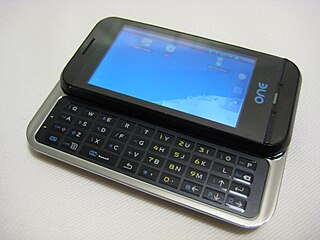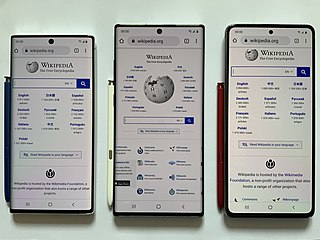
BlackBerry was a brand of smartphones and other related mobile services and devices. The line was originally developed and maintained by the Canadian company BlackBerry Limited from 1999 to 2016, after which it was licensed to various companies.

A smartphone is a mobile device that combines the functionality of a traditional mobile phone with advanced computing capabilities. It typically has a touchscreen interface, allowing users to access a wide range of applications and services, such as web browsing, email, and social media, as well as multimedia playback and streaming. Smartphones have built-in cameras, GPS navigation, and support for various communication methods, including voice calls, text messaging, and internet-based messaging apps.
Sony Mobile Communications Inc. was a multinational telecommunications company founded on October 1, 2001, as a joint venture between Sony Corporation and Ericsson. It was originally incorporated as Sony Ericsson Mobile Communications, and headquartered in London, England, until Sony acquired Ericsson's share in the venture on February 16, 2012. On April 1, 2021, Sony integrated its electronics businesses including Sony Mobile into one company called Sony Corporation.

Windows Mobile is a discontinued mobile operating system developed by Microsoft for smartphones and personal digital assistants.

Motorola Mobility LLC, marketed as Motorola, is an American consumer electronics manufacturer primarily producing smartphones and other mobile devices running Android. Headquartered at Merchandise Mart in Chicago, Illinois, it is a subsidiary of the multinational technology company Lenovo.

The iPhone is a line of smartphones produced by Apple Inc. that use Apple's own iOS mobile operating system. The first-generation iPhone was announced by then–Apple CEO Steve Jobs on January 9, 2007. Since then, Apple has annually released new iPhone models and iOS updates. As of November 1, 2018, more than 2.2 billion iPhones had been sold.
Android is a mobile operating system based on a modified version of the Linux kernel and other open-source software, designed primarily for touchscreen mobile devices such as smartphones and tablets. Android is developed by a consortium of developers known as the Open Handset Alliance, though its most widely used version is primarily developed by Google. It was unveiled in November 2007, with the first commercial Android device, the HTC Dream, being launched in September 2008.
A mobile operating system is an operating system used for smartphones, tablets, smartwatches, smartglasses, or other non-laptop personal mobile computing devices. While computers such as typical/mobile laptops are "mobile", the operating systems used on them are generally not considered mobile, as they were originally designed for desktop computers that historically did not have or need specific mobile features. This line distinguishing mobile and other forms has become blurred in recent years, due to the fact that newer devices have become smaller and more mobile unlike hardware of the past. Key notabilities blurring this line are the introduction of tablet computers, light-weight laptops, and the hybridization of the two in 2-in-1 PCs.

The HTC Dream is a smartphone developed by HTC. First released in September 2008 for $179 with a 2-year contract to T-Mobile, the Dream was the first commercially released device to use the Linux-based Android operating system, which was purchased and further developed by Google and the Open Handset Alliance to create an open competitor to other major smartphone platforms of the time, such as Symbian, BlackBerry OS, and iPhone OS. The operating system offers a customizable graphical user interface, integration with Google services such as Gmail, a notification system that shows a list of recent messages pushed from apps, and Android Market for downloading additional apps.

A feature phone is a type or class of mobile phone that retains the form factor of earlier generations of mobile telephones, typically with press-button based inputs and a small non-touch display. They tend to use an embedded operating system with a small and simple graphical user interface, unlike large and complex mobile operating systems such as Android from Google or iOS from Apple. Their functions are limited compared to smartphones, which integrate the phone with an Internet communications device, although feature phones can provide functions found in smartphones, including Internet capabilities and mobile games.

Symbian is a discontinued mobile operating system (OS) and computing platform designed for smartphones. It was originally developed as a proprietary software OS for personal digital assistants in 1998 by the Symbian Ltd. consortium. Symbian OS is a descendant of Psion's EPOC, and was released exclusively on ARM processors, although an unreleased x86 port existed. Symbian was used by many major mobile phone brands, like Samsung, Motorola, Sony Ericsson, and above all by Nokia. It was also prevalent in Japan by brands including Fujitsu, Sharp and Mitsubishi. As a pioneer that established the smartphone industry, it was the most popular smartphone OS on a worldwide average until the end of 2010, at a time when smartphones were in limited use, when it was overtaken by iOS and Android. It was notably less popular in North America.

Bump was an iOS and Android mobile app that enabled smartphone users to transfer contact information, photos and files between devices. In 2011, it was #8 on Apple's list of all-time most popular free iPhone apps, and by February 2013 it had been downloaded 125 million times. Its developer, Bump Technologies, shut down the service and discontinued the app on January 31, 2014, after being acquired by Google for Google Photos and Android Camera.

The GeeksPhone One is an Android-powered smartphone developed and marketed by GeeksPhone. It is aimed at power users; GeeksPhone claims it to be the first Android phone which is not locked down but gives users full access to the operating system and even encourages modifying it. The device was originally priced at €300 in the EU, lowered to €160 in December 2010, and is currently out of stock.

The Samsung Galaxy 3, also known as the Samsung Galaxy Apollo, Samsung Galaxy Mini in Italy, or Samsung Galaxy 580 in Hong Kong, is a smartphone manufactured by Samsung that runs the open source Android operating system. Announced and released by Samsung in July 2010, the Galaxy 3 succeeds the Samsung Galaxy Spica.

GeeksPhone was a Spanish smartphone company founded in 2009. GeeksPhone's most notable products are open Android phones and developer devices of Firefox OS.

Lenovo smartphones are marketed as the "LePhone" in Mainland China and the "IdeaPhone" overseas are smartphones desgined and manufactured by the Motorola Mobility, ZUK Mobile and Medion, divisions of Lenovo. On April 27, 2017, Lenovo announced that the ZUK brand would cease operations. In 2015, Lenovo subsumed its own smartphone division into the acquired Motorola brand.

Microsoft Lumia is a discontinued line of mobile devices that was originally designed and marketed by Nokia and later by Microsoft Mobile. Introduced in November 2011, the line was the result of a long-term partnership between Nokia and Microsoft—as such, Lumia smartphones run on Microsoft software, the Windows Phone operating system; and later the newer Windows 10 Mobile. The Lumia name is derived from the partitive plural form of the Finnish word lumi, meaning "snow".

A phablet is a mobile device combining or straddling the size formats of smartphones and tablets. The word is a portmanteau of phone and tablet. As of 2020, most budget and entry-level Android smartphones offered in emerging markets can be considered as "phablets", as they have at least a 6.5 inches (165 mm) diagonal screen length and an overall vertical length of at least 6.3 inches (160 mm).

The Samsung Galaxy S6 is a line of Android-based smartphones manufactured, released and marketed by Samsung Electronics. Succeeding the Samsung Galaxy S5, the S6 was not released as a singular model, but instead in two variations unveiled and marketed together—the Galaxy S6 and Galaxy S6 Edge—with the latter differentiated primarily by having a display that is wrapped along the sides of the device. It is distinguished from its predecessor through a battery with an increased charging speed but a decreased capacity, an optically stabilized camera, sound in slow motion video recordings, a glass back, and it lacks a user-replaceable battery, a memory card slot, water resistance, and MHL-to-HDMI connection for viewing on an external monitor or television set.

Human Mobile Devices (HMD), formally HMD Global, is a Finnish mobile phone manufacturer. The company is made up of the mobile phone business that the Nokia Corporation sold to Microsoft in 2014, then bought back in 2016. HMD began marketing Nokia-branded smartphones and feature phones on 1 December 2016. The company has exclusive rights to the Nokia brand for mobile phones through a licensing agreement. The HMD brand was initially only used for corporate purposes and does not appear in advertising, whereas the name "Nokia Mobile" is used on social media. As it was launched, the acronym HMD stood for Hon Hai Mobile Devices. This was in reference to the main shareholder at the time of its creation: the Taiwanese group Foxconn. In January 2024, HMD rebranded to 'Human Mobile Devices', and will use their own branding on future devices alongside that of Nokia.
















